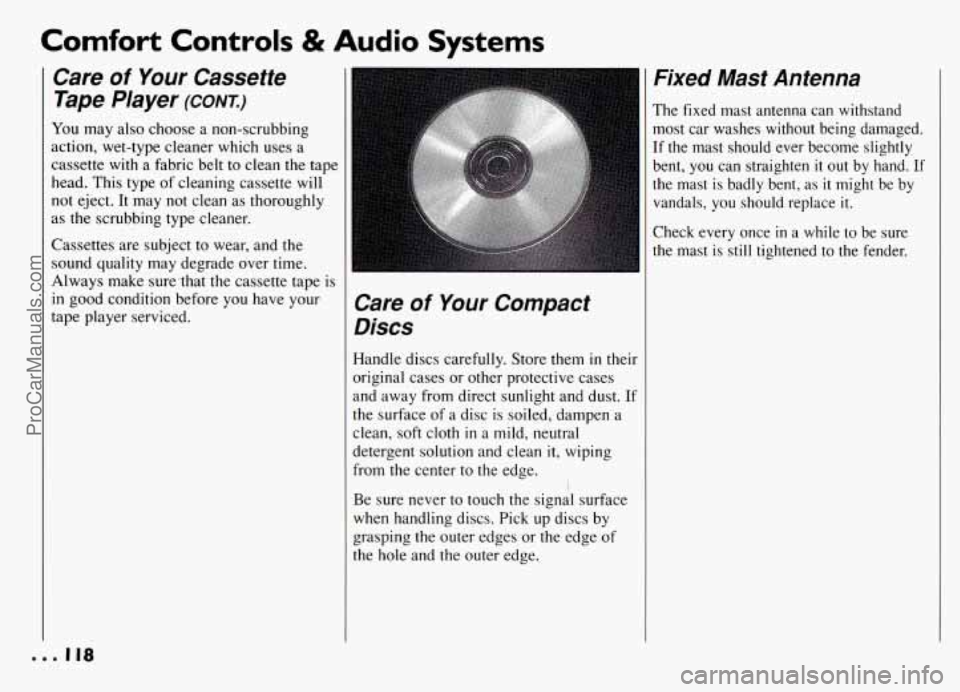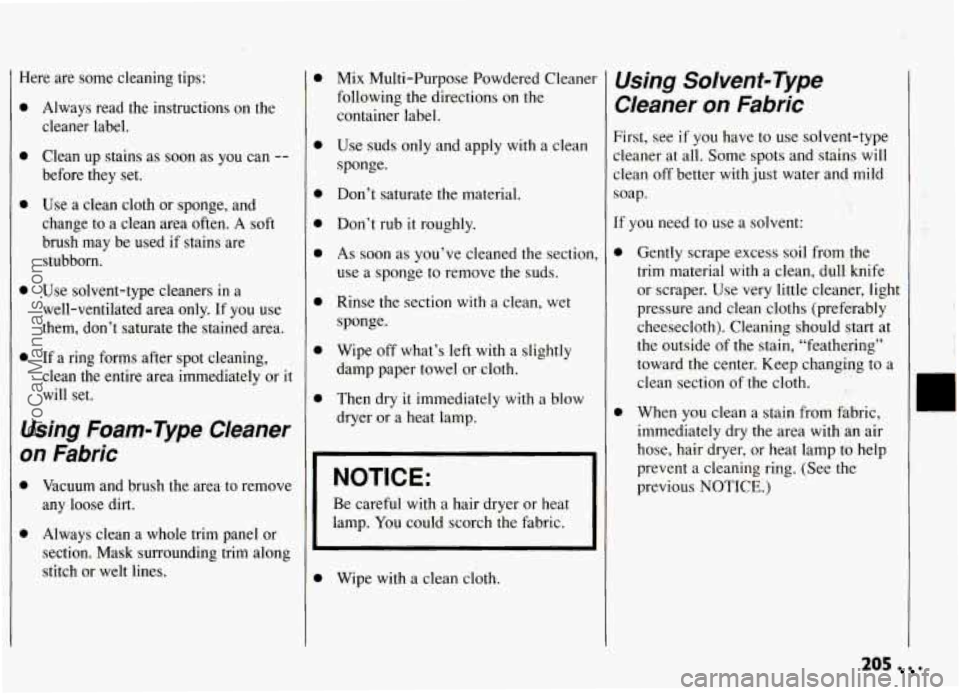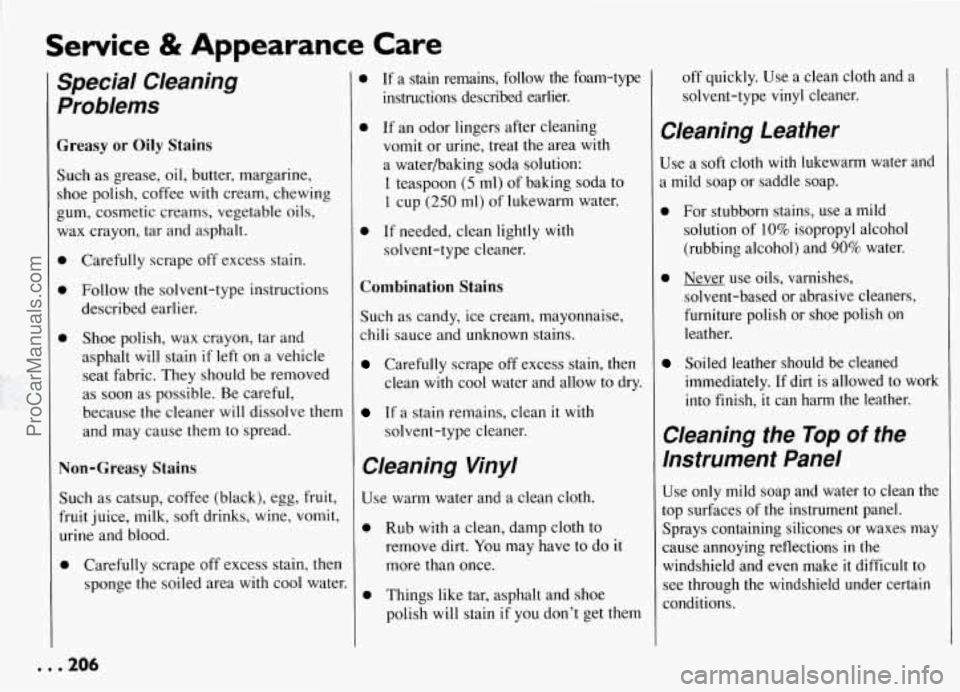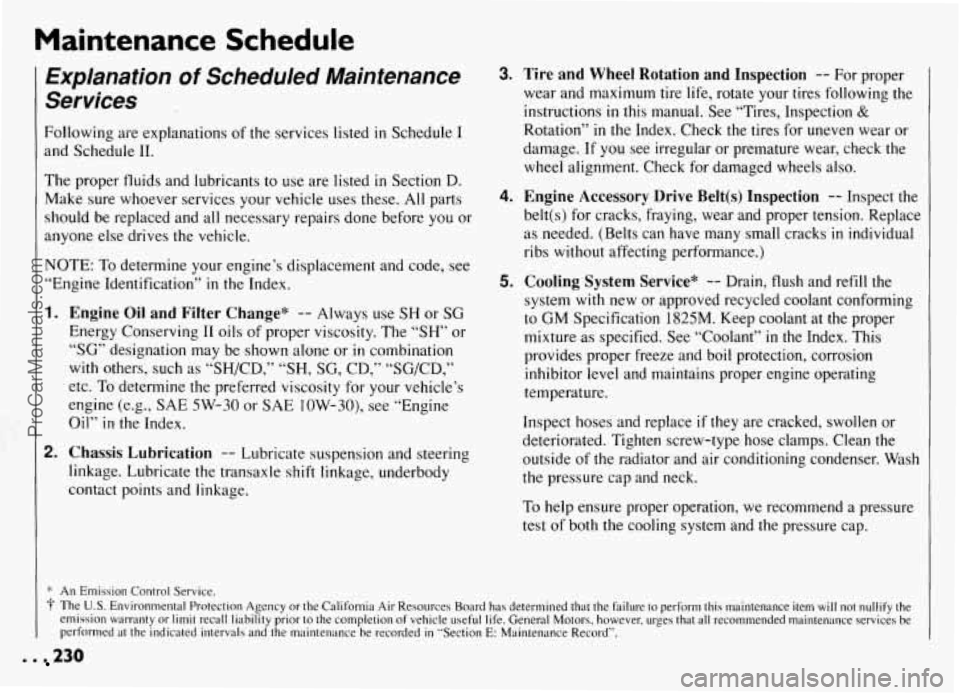1994 PONTIAC GRAND-AM oil type
[x] Cancel search: oil typePage 119 of 274

Comfort Controls & Audio Systems
Care of Your Cassette
Tape Player
(CONT.)
You may also choose a non-scrubbing
action, wet-type cleaner which uses
a
cassette with a fabric belt to clean the tape
head. This type of cleaning cassette will
not eject. It may not clean as thoroughly
as the scrubbing type cleaner.
Cassettes are subject to wear, and the
sound quality
may degrade over time.
Always make surepthat the cassette tape is
in good condition before you have your
tape player serviced. Care of Your Compact
Discs
Handle discs carefully. Store them in thei
original cases or other protective cases
and away from direct sunlight and dust.
I
the surface of a disc is soiled, dampen a
clean, soft cloth
in a mild, neutral
detergent solution and clean
it, wiping
from the center to the edge.
Be sure never to touch the signal surface
when handling discs. Pick up discs by
grasping the outer edges or the edge
of
the hole and the outer edge.
I
Fixed Mast Antenna
The fixed mast antenna can withstand
most car washes without being damaged.
If the mast should ever become slightly
bent, you can straighten
it out by hand. If
the mast is badly bent, as it might be by
vandals, you should replace it.
Check every once in a while to be sure
the mast is still tightened to the fender.
... 118
ProCarManuals.com
Page 206 of 274

Here are some cleaning tips:
0
0
0
0
0
Always read the instructions on the
cleaner label.
Clean up stains as soon as you can
--
before they set.
Use a clean cloth or sponge, and
change to a clean area often. A soft
brush may be used if stains are
stubborn.
Use solvent-type cleaners in a
well-ventilated area only. If you use
them, don’t saturate the stained area.
If a ring forms after spot cleaning,
clean the entire area immediately or
it
will set.
Using Foam-Type Cleaner
on Fabric
0 Vacuum and brush the area to remove
any loose dirt.
0 Always clean a whole trim panel or
section. Mask surrounding trim along
stitch or welt lines.
0
0
0
0
0
0
0
0
Mix Multi-Purpose Powdered Cleaner
following .the directions on the
container label.
Use suds only and apply with a clean
sponge.
Don’t saturate the material.
Don’t rub
it roughly.
As soon as you’ve cleaned the section,
use a sponge to remove the suds.
Rinse
the section with a clean, wet
sponge.
Wipe off what’s left with a slightly
damp paper towel
or cloth.
Then dry it immediately with a blow
dryer or
a heat lamp.
NOTICE:
Be careful with a hair dryer or heat
lamp. You could scorch the fabric. ~
0 Wipe with a
clean cloth.
Using Solvent-Type
Cleaner on Fabric
First, see if you have to use solvent-type
cleaner at all. Some spots and stains will
clean off better
with just water and mild
soap.
If you need to use a solvent:
0
0
Gently scrape excess soil from the
trim material with a clean, dull knife
or scraper. Use very little cleaner, light
pressure and clean cloths (preferably
cheesecloth). Cleaning should start at
the outside
of the stain, “feathering”
toward the center. Keep changing to a
clean section of the cloth.
When you clean a stain from fabric,
immediately dry the area with an air
hose, hair dryer, or heat lamp to help
prevent a cleaning ring. (See the
previous NOTICE.)
205 .
ProCarManuals.com
Page 207 of 274

Service & Appearance Care
Special Cleaning
Problems
Greasy or Oily Stains
Such as grease, oil, butter, margarine,
shoe polish, coffee
with cream, chewing
gum, cosmetic creams, vegetable oils,
wax crayon, tar and asphalt.
Carefully scrape off excess stain.
Follow the solvent-type instructions
described earlier.
Shoe polish, wax crayon, tar and
asphalt will stain if
left on a vehicle
seat fabric. They should be removed
as soon as possible. Be careful,
because the cleaner will dissolve them
and may cause them to 'spread.
Non-Greasy Stains
Such as catsup, coffee (black), egg, fruit,
fruit juice, milk, soft drinks, wine, vomit,
urine and blood.
0 Carefully scrape off excess stain, then
sponge the soiled area with cool water.
D If a stain remains, follow the foam-type
instructions described earlier.
B If an odor lingers after cleaning
vomit or urine, treat the area with
a waterbaking soda solution:
1 teaspoon (5 ml) of baking soda to
1 cup (250 ml) of lukewarm water.
B If needed, clean lightly with
solvent-type cleaner.
Combination Stains
Such as candy, ice cream, mayonnaise,
:hili sauce and unknown stains.
Carefully scrape off excess stain, then
clean with cool water and allow to dry.
If a stain remains, clean it with
solvent-type cleaner.
Cleaning Vinyl
Use warm water and a clean cloth.
0 Rub with a clean, damp cloth to
remove dirt. You may have to do it
more than once.
0 Things like tar, asphalt and shoe
polish will stain if you don't get them
off quickly. Use a clean cloth and a
solvent-type vinyl cleaner.
Cleaning Leather
Jse a soft cloth with lukewarm water and
L mild soap or saddle soap.
B For stubborn stains, use a mild
solution of 10% isopropyl alcohol
(rubbing alcohol) and
90% water.
Never use oils, varnishes, solvent-based or abrasive cleaners,
furniture polish
or shoe polish on
leather.
Soiled leather should be cleaned
immediately. If dirt is allowed to work
into finish,
it can harm the leather.
Cleaning the Top of the
Instrument Panel
Use only mild soap and water to clean the
top surfaces of the instrument panel.
Sprays containing silicones or waxes may
cause annoying reflections
in the
windshield and even make
it difficult to
see through the windshield under certain
conditions.
. . .206
ProCarManuals.com
Page 221 of 274

Service & Appearance Care
Normal Maintenance Replacement Parts
Air Cleaner Element
2.3L Quad OHC and Quad 4 ....................
3.lLV6 ....................................
Engine Oil Filter
2.3L Quad OHC and Quad 4 ....................
3.1LV6 ....................................
PCV Valve
3.1LV6 ....................................
Spark Plugs
2.3L Quad OHC ..............................
2.3L Quad DOHC with Automatic Transaxle .......
2.3L Quad DOHC with Manual Transaxle .........
2.3L Quad High Output ........................
3.1LV6 ....................................
AC Type A- 1233C
AC Type A-1233C
AC Type PF- 1225
AC Type PF-40
or AC Type PF-47
AC Type 892C
AC Type 041-603
Gap: 0.035 inch (.889 mm)
AC Type 04 1-603
Gap: 0.035 inch (.889
mm)
AC Type 041-602
Gap: 0.035 inch (389 mm)
AC Type 04 1-602
Gap: 0.035 inch
(.889 mm)
AC Type R44 LT SM6
Gap: 0.060 inch (1.52 mm)
... 220
ProCarManuals.com
Page 231 of 274

Maintenance Schedule
Explanation of Scheduled Maintenance
Services
Following are explanations of the services listed in Schedule I
and Schedule 11.
The proper fluids and lubricants to use are listed in Section D.
Make sure whoever services your vehicle uses these. All parts
should be replaced and all necessary repairs done before you or
anyone else drives the vehicle.
NOTE: To determine your engine’s displacement and code, see
“Engine Identification”
in the Index.
1.
2.
Engine Oil and Filter Change* -- Always use SH or SG
Energy Conserving I1 oils of proper viscosity. The “SH” or
“SG” designation may be shown alone or in combination
with others, such as “SH/CD,” “SH, SG, CD,” “SG/CD,”
etc. To determine the preferred viscosity for your vehicle’s
engine (e.g., SAE 5W-30 or SAE 10W-30), see “Engine
Oil”
in the Index.
Chassis Lubrication -- Lubricate suspension and steering
linkage. Lubricate the transaxle shift linkage, underbody
contact points and linkage.
3.
4.
5.
Tire and Wheel Rotation and Inspection -- For proper
wear and maximum tire life, rotate your tires following the
instructions
in this manual. See “Tires, Inspection &
Rotation” in the Index. Check the tires for uneven wear or
damage. If you see irregular or premature wear, check the
wheel alignment, Check for damaged wheels also.
Engine Accessory Drive Belt(s) Inspection -- Inspect the
belt(s) for cracks, fraying, wear and proper tension. Replace
as needed. (Belts can have many small cracks
in individual
ribs without affecting performance.)
Cooling System Service* -- Drain, flush and refill the
system with new or approved recycled coolant conforming
to
GM Specification 1825M. Keep coolant at the proper
mixture as specified. See “Coolant”
in the Index. This
provides proper freeze and boil protection, corrosion
inhibitor level and maintains proper engine operating
temperature.
Inspect hoses and replace if they are cracked, swollen or
deteriorated. Tighten screw-type hose clamps. Clean the
outside of the radiator and air conditioning condenser. Wash
the pressure cap and neck.
To help ensure proper operation, we recommend a pressure
test of both the cooling system and the pressure cap.
. . 230
ProCarManuals.com
Page 232 of 274

6. Transaxle Service -- For manual transaxles, fluid doesn’t
require changing. See “Periodic Maintenance Inspections.”
For automatic transaxles, change both the fluid and filter
every
15,000 miles (25 000 km) if the vehicle is mainly
driven under one or more of these conditions:
* In heavy city traffic where the outside temperature
regularly reaches 90°F (32°C) or higher.
0 In hilly or mountainous terrain.
0 When doing frequent trailer towing.
0 Uses such as found in taxi, police car or delivery
service.
If you -do not use your vehicle under any of these
conditions, change both the fluid and filter every
100,000 miles ( 166 000 km).
7. Spark Plug Replacement* -- Replace spark plugs with
the proper type. See “Replacement Parts” in the Index.
8. Spark Plug Wire Inspection (3.1L Code M engine
only)*?
-- Inspect for burns, cracks or other damage.
Check
the boot fit at the coils and at the spark plugs.
Replace wires as needed.
9. Air Cleaner Filter Replacement* -- Replace every
30,000 miles (50 000 km) or more often under dusty
conditions.
Ask your dealer for the proper replacement
intervals for your driving conditions.
1 O.Fuel Tank, Cap and Lines Inspection”? -- Inspect fuel
tank, cap and
lines (including fuel rails and injection
assembly) for damage or leaks. Inspect
fuel cap gasket for
an even filler neck imprint or any damage. Replace parts as
needed. Periodic replacement of the fuel filter is
not
required.
* An Emission Control Service.
3- The U.S. Environmental Protection Agency or the California Air Resources Board has determined that the failure to perform this maintenance item will not nullify the
emission warranty or limit recall liability prior to the completion of vehicle useful life. General Motors, however, urges that all recommended maintenance services be performed at the indicated intervals and the maintenance be recorded in “Section E: Maintenance Record”.
ProCarManuals.com
Page 265 of 274

Index
Changing a Flat Tire ............. 162
“Check Gauges” Light
........... 100
Check Oil Light ................. 96
Engine Coolant .............. 188
Engine Oil Level
............. 179
Hydraulic Clutch
............. 187
Power Steering Fluid
......... 190
Safety Belt Systems
........... 42
Automatic ............... 184
Manual
.................. 186
Checking Things Under the Hood
. . 175
Checks
& Services. Owner ....... 232
Chemical Paint Spotting
.......... 209
Child Restraints
................. 33
Children and Safety Belts
......... 32
Circuit Breakers & Fuses ......... 2 12
Charging System Warning Light .... 97
Checking
Brake Fluid ................. 191
Transaxle Fluid
Cigarette Lighter ................ 86
City Driving
................... 132
Cleaner. Air
................... 183
Aluminum Wheels ........... 208
Antenna
.................... 1 18
Cassette Player and Tapes ...... 117
Compact Discs
.............. 11 8
Finish Damage .............. 209
Foreign Material
............. 209
Cleaning
Fabric ..................... 205
Glass ...................... 207
Inside of Your Pontiac ........ 204
Leather and Vinyl
............. 206
Outside of Your Pontiac
....... 208
Safety Belts
................. 207
Sheet Metal Damage
.......... 209
Special Problems
............ 206
Top of the Instrument Panel
.... 206
Underbody Maintenance
....... 209
Using Solvent Type Cleaner
.... 205
Warnings
........... 204.205. 207
Weatherstrips
............... 209
White Sidewall Tires
.......... 208
Windshield and Wiper Blades
... 207
Climate Control System .......... 102
Clock. Setting the
............... 107
Adding Fluid ................ 187
Checking Fluid
.............. 187
Coin Holder
.................... 86
Comfort Controls
............... 101
Air Conditioning System
...... 103
Climate Control System
....... 102
Defrosting
.................. 104
Heater
..................... 102
Ventilation
.................. 103
Clutch. Hydraulic
Compact Disc Player (see “Audio
Systems”)
Compact Spare Tire ............. 167
Control of a Vehicle
............. 122
Controlled-Cycle Windshield
Wipers ....................... 81
Convex Outside Mirror
........... 83
Coolant ....................... 188
Low Coolant Warning Light
..... 94
Safety Warnings. About
... 188. 189
Temperature Warning Light
..... 94
Thermostat ................. 190
Corrosion Protection
............ 209
Cruise Control
.................. 74
Cup Holders
.................... 85
Curves. Driving on
.............. 125
Checking & Adding .......... 188
Proper Mixture to Use
........ 188
Temperature Gage
............. 94
Customer Assistance Information . . 243
Daytime Running Lights ......... 77
Dead Battery: What to Do ........ 148
Defects. Safety. Reporting (see
“Safety Defects”)
Defensive Driving .............. 120
Defogger. Rear Window
......... 105
Defogging Your Windows
........ 102
Door Locks
..................... 47
Door. Remote Fuel Filler
......... 174
Downshifting
................ 62. 66
Driver Position .................. 17
Driving
At Night ................... 129
City
....................... 132
Controlling a Skid
............ 128
Defensive
.................. 120
Drunken
................... 120
Freeway
..................... 132
. 264
ProCarManuals.com